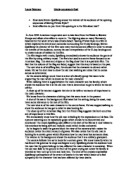Analyze and comment on the effectiveness of media devices used to present war in sections of 'Braveheart' and Saving Private Ryan'
Analyze and comment on the effectiveness of media devices used to present war in sections of ‘Braveheart’ and Saving Private Ryan’
Different media devices were used for effectiveness to present war in sections of ‘Braveheart’ and ‘Saving Private Ryan.’ In both sections of the films battle scene, it brings all reality into the living nightmare that took place. Brought back into life by Spielberg and Gibson, I will show how media devices are used to present war in the most realistic ways. I will discuss how the sections portray the characters, use of sounds, and the use of camera shots and how they contribute to the overall effect of the scenes.
One of the movies I will be looking at is Saving Private Ryan. Saving Private Ryan is an action packed movie directed by Steven Spielberg. The 1998 multi Oscar winning film illustrates the struggle of a set of men on a mission to retrieve a soldier from the front line after the beach landings in France. The film is set on the coast of northern France during the Second World War. The actual date the events take place on is the 6th of June 1944. The lead role was played by Tom Hanks who take the character of Captain Miller, the leader of the mission.
The other movie I will be looking at is Braveheart. Braveheart is a passionate blockbuster about Scottish hero William Wallace, a commander who, from 1927 to 1305 AD, led revolt against the ruling English that eventually led to the independence of Scotland. It is also a multi Oscar winning movie, and was directed by the main character: Mel Gibson. Until Braveheart came out, Wallace was not a particularly well known historical figure outside of Scotland. But, Mel Gibson’s almost three hour ‘tour de force of film making’ changed all of that.
The opening sequence of Saving Private Ryan is the most realistic, horrifying and shocking scenes throughout the movie. The film is very bloody, and shows the reality of war. During the films battle scene, many media devices are used to effect the audience’s emotions in some way. Camera Shots plays a big part in affecting the audience as different camera positions can alter the mood of the audience in diverse ways. The first shot of the scene looked at the metal pegs stretched along the beach. The US army moves in on a boat, ready to attack. We see the leader, Captain John Miller look at the front, and then we look down the boat and see troopers vomiting, scared, kissing their crucifix and acting out the sign of the cross. This creates a tense atmosphere and is a good technique used by Spielberg as it portrays sympathy and suspense as it engages the audience. At this point it seems as if a handheld camera is being used, it moves freely around the boat and shakes when the boat hits the waves. This gives the audience a feel of what the soldiers were going through when they were on the boat. Spielberg deliberately shot the film in the distinctive ‘hand held’ camera style to give an effect of realism and this effect I think was successful as it brings the viewers closer to the action. There were also close-up shots of soldier’s terrified expression which creates a mood of fear and tension and emphasizes on the soldiers emotions. As the whistle sounds, the war begins, Spielberg wonderfully throws the camera at such a dizzying pace, that the audience is lifted right from their seats and into the war itself. Every bomb, every gunshot, every scream was real. When the soldiers got out of the Higgins boat we hear bullets zip through the air killing the soldiers suggesting that the Americans had no escape and could not back down now as it was too late. The camera even went underwater to show soldiers getting shot and the blood mixing with the dirty sea water. The camerawork brings the audience close to the action and gives them an overview of the carnage. The camera then cuts to an over the shoulder shot gives German perspective emphasising a sense of power and advantage over the Americans. This high angled shot of the Germans indicates to the audience of the immense difficulty of the mission. All the way through the beach scene there are guns shots going off and bombs exploding, the actors have to really shout to be heard, the viewers can tell from this how hard it was for the military to give and receive orders, the audience can understand from this how simple it would have been to get the instructions wrong and be gunshot down doing the wrong thing.







